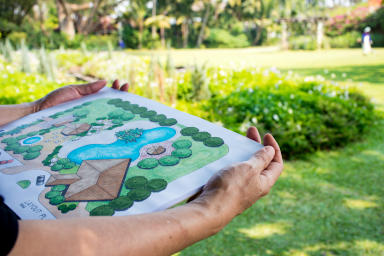A Family Guide To Reducing, Reusing, and Recycling At Home

The need for environmental action to mitigate global warming and pollution remains as urgent as ever. Each person in the U.S. generates almost five pounds of waste per day and only about 30% of it is recycled. This means that a family of four can easily send over 2.5 tons of trash to rot in landfills each year, exacerbating climate change, hurting biodiversity and negatively affecting our health. Saving our planet will require a team effort, from government and business leaders all the way down to families in their homes. Every little bit each of us can do matters, and even kids can lead a family’s efforts to go green. All it takes is a little planning and the three Rs.
The Three Rs
Everyone knows the three Rs — ‘Reduce, Reuse, and Recycle’ — but have you ever wondered about their order? It’s more than just a catchy-sounding coincidence. They’re ranked in order of importance: The first and most important step is to reduce what we buy. Imagine a new pair of sneakers. From the rubber trees that make the sole to the machines that sew the final stitch, those sneakers consume energy and generate emissions long before arriving at the store. Reducing the toys, clothes and electronics we use in our homes or daily lives means less waste sent to landfills, but it also means we also reduce all that extra impact from making it in the first place. Reducing can only take us so far. Wanting new things is a normal part of life, and that’s OK! Things break and need replacing or sometimes we just want to try something new. But before we rush off to the store, we can check to see if there’s something we can reuse instead. Reusing means taking a look at things that already exist — either at home or in your local community — and seeing if we can find creative ways to use them again. After you reduce all you can and reuse wherever possible, the next step is to make sure you recycle. Recycling reduces our dependence on the extraction of non-renewable raw materials, a process which is energy-intensive and can harm biodiversity. Using recycled materials to create new products means more forests stay standing, less mining, fewer plastics contaminating the oceans and less fossil fuels burned. With so many places in the home to reduce, reuse and recycle, it’s easy to get started.
In The Kitchen
As one of the largest contributors to household waste, the kitchen has many opportunities for a three-R makeover. 30% of food in the U.S. becomes food waste, which decomposes in landfills and releases 3.3 gigatons of greenhouse gas annually. The kitchen can also be a major source of water and plastic waste, so think about how you can reduce, reuse and recycle in all kitchen activities:
Reduce packaging
Reducing in the kitchen starts at the supermarket. Remember to take your reusable shopping and produce bags to reduce plastic waste, and look for products that come in the least amount of packaging. Local fruits and veggies are package-free and have the lowest environmental impact, but only if they get eaten before spoiling, reused as leftovers, or composted.
Compost Food Scraps
Composting reuses food scraps by turning them into valuable soil to grow new food, but American homes are only composting about 3% of their food waste, and most of it ends up rotting in landfills. Instead, learn the basics about converting compost to soil and get started with as little as a composting bin.
Use the dishwasher — but only on a full load
Modern dishwashers are more water-efficient than hand washing, but not if they run half-empty. Reduce the number of washes by waiting for the dishwasher to fill before you run it, which can save up to 320 gallons of water a year.
Start a recycling system
Only 9% of global plastics are ever recycled and the U.S. produces more plastic waste — about 92.6 billion pounds — than any other country in the world. An efficient sorting system in the kitchen, where most waste accumulates, is the best way to ensure it gets recycled once it leaves the house. Go online and find out about your local recycling programs and which materials are recyclable in your area. Then, when you buy new stuff, make sure it comes in recyclable packaging.
In The Bathroom
The bathroom is another place in the home that can accumulate plastic waste, but the biggest resource drain is on water. Water is directly linked to issues of climate change and pollution, but only 0.5% of the planet’s freshwater is drinkable, so every drop counts.
Reduce water waste
Opt for showers over baths and take shorter showers. Avoid letting the water run when you’re not using it. Turning off the water flow while you brush your teeth, for example, can save nearly 5,700 gallons a year.
Improve water efficiency
Our water-dispensing appliances can do a better job with the right equipment. Filling a plastic bottle with pebbles and fitting it into your toilet tank can save around 3,000 gallons per year, and water-efficient showerheads can save up to 2,700.
Install a bidet
Every traveler to Europe comes back loving the bidet, so why not try one in your bathroom. Hard to imagine that washing yourself after the toilet could be more water efficient, but a bidet only uses one-eighth of a gallon compared to the 37 gallons needed to make a single roll of toilet paper. Using a bidet can also avoid the 27,000 trees per day in toilet paper waste.
Think again about packaging
Beauty and hygiene products can come with a deluge of plastic packaging, so set up a bin to collect them for recycling in the bathroom. Not all plastics are recyclable, so check before the number you buy and go for the most easily recycled option. Or ditch the plastic altogether with innovative products like hair care bars that come plastic-free and last for more washes.
Around The House
In every room you look, you can probably find ways to implement the three Rs:
Reduce energy and water waste
Everyone thinks of turning off incandescent lights to save energy, but unless you plan to keep them off for over 15 minutes, fluorescents should stay on for greater efficiency. Unplug devices when not in use to reduce phantom energy pull, which can account for over 20% of household energy consumption and 4.6% of residential carbon emissions. Check your home regularly for leaky pipes and faucets, which can waste up to 9,400 gallons a year.
Rethink your wardrobe waste
One garbage truck of textiles is landfilled or burned every second, and the fashion industry accounts for 10% of global carbon emissions, so stitch up before buying new. Sew old T-shirts into pillows or reusable tote bags. Donate your old clothes or turn items too tattered for donations into rags for cleaning the house.
Repurpose old cloths
Once you have enough rags, you can use them to clean instead of paper towels. Americans use 85 million tons of paper annually, but each ton of paper we save would preserve 17 trees, which can absorb 250 pounds of CO2 from the air each year.
Recycled and recyclable office supplies
Set up a paper recycling bin where you do most of your home office work. Before you choose recycling, however, remember first to reduce your paper needs by printing double-sided or reuse blank sides to make small notepads. You can also look for office materials with “recycled” options, like notebooks from recycled paper, pens of recyclable plastic or compostable pencils.
Taking Action Starts At Home
There are so many ways to reduce, reuse and recycle around your home, so brainstorm ideas by thinking about which rooms produce the most waste and how the three R’s might apply. Talk to your parents about your plans and encourage them to participate. Remind them of the savings that come from reducing a home’s environmental footprint. Get creative with charts to measure your energy and waste reduction as you go and suggest ways they can reward your achievements. With the right support, innovation can come from anyone, at any age. Greta Thunburg was only 15 when she first sat on the steps of Swedish Parliament to call for climate action and now, her voice inspires millions. Kids who take on environmental responsibilities at home not only relieve the pressure on their parents to reduce their family footprint, but also prepare themselves to step up as the next generation of environmental leaders.
Grace BarrettAuthor
Former designer, teacher, and chef with degrees in political science, Latin America and fine arts turned freelance writer, Grace Barrett writes to fuel her passion for learning, health and sustainability.




